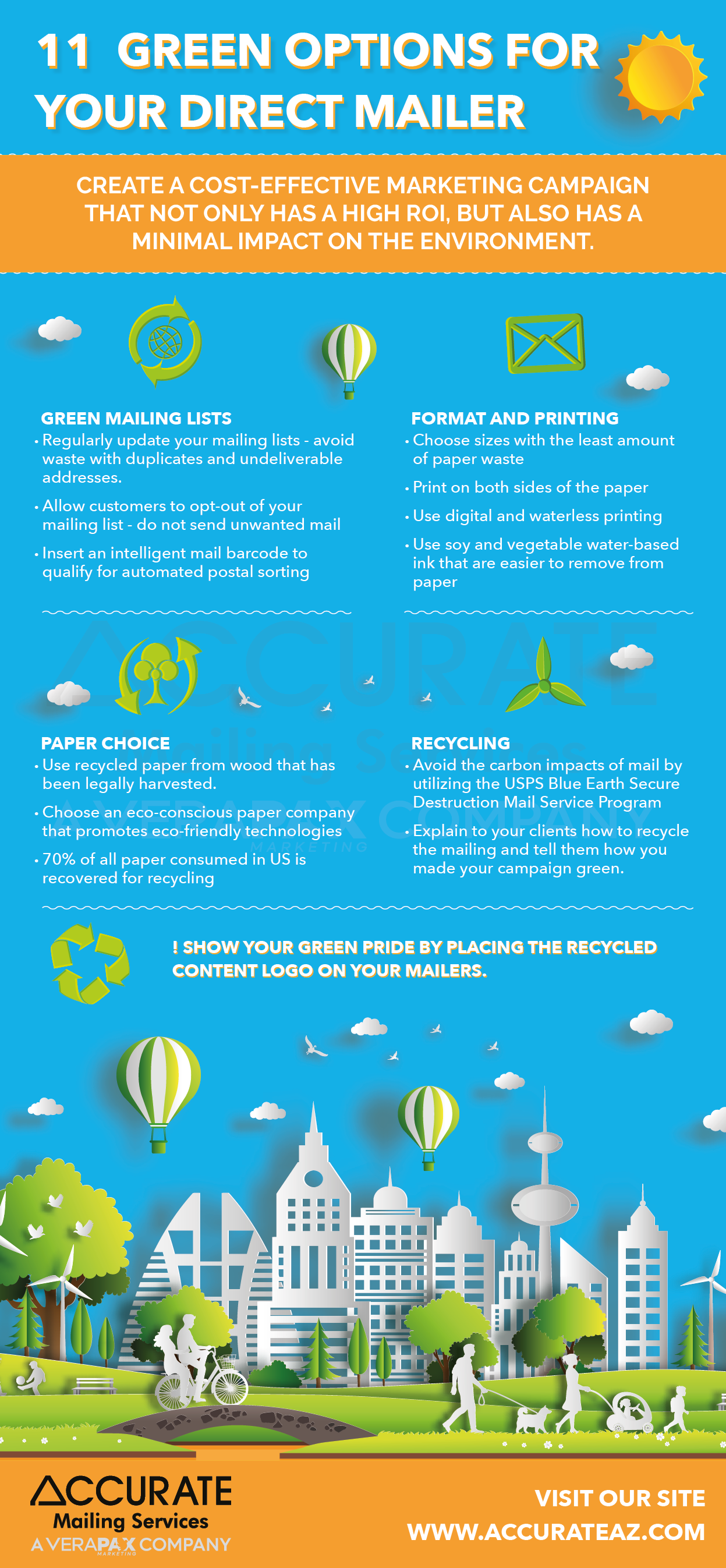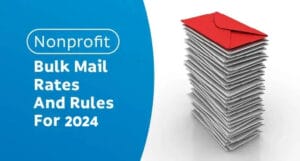Green direct mail: is it possible?
On the surface, direct mail marketing appears to be bad for the environment. But, according to a study performed by Pitney Bowes, direct mail accounts for only about 2% of the total tonnage of the US municipal waste stream and almost 39% of direct mail in the US was recycled in 2006. While it may be not as wasteful as you originally thought, there are steps you can take to go the extra mile and send a successful green direct mail campaign.
It is more popular than ever to “go green”. Whether it be by going paperless as a business or driving a hybrid vehicle, there are many options to reduce your carbon footprint as an individual and as a business. If your goal is to reduce your business’ environmental impact, you’ll want to incorporate green direct mail practices into your marketing campaigns. Here are a few green direct mail options to inspire you:

1. Use recycled paper
Did you know that 70% of all paper consumed in the US is recovered for recycling? Using recycled paper is the perfect option for any direct mail campaign. Beyond recycled paper, you can opt for a paper that is sourced from legally harvested wood, or even paper that is not made out of wood at all (for example, sugar cane paper). Additionally, there are biodegradable options for your paper needs. Using a biodegradable envelope or postcard can send the right message to your target customer, or just simply help eliminate waste.
2. Be creative with “seed paper”
If you really want to give your customer some inspiration, print on “seed paper”. This paper is biodegradable paper with seeds inside of it. Instruct your recipient to plant the paper, and they can enjoy the benefit of beautiful wildflowers. They’ll surely think of you each time they smell or see the beautiful flowers.
3. Leave Toxic Ink Behind
Choose eco-friendly inks. Conventional ink can be difficult to strip from paper during the recycling process. This fact is something that you may never have considered but can make a profound difference in the environment. Eco-friendly options for ink include soy and vegetable-based inks, as well as water-based inks.
What is the difference between petroleum-based inks and vegetable-based, soy-based, or water-based inks? Petroleum-based inks release volatile organic compounds (VOC’s) as they dry. This lead to air pollution and ultimately contributes to global warming. Additionally, petroleum-based inks are derived from non-renewable resources. Finite resources are depleted with each printing job. Additionally, petroleum-based inks tend to be more expensive than water-based, soy-based, or vegetable-based inks. By choosing an alternative ink, you can reduce your impact on the environment without sacrificing quality.
4. Clean your mailing list
Direct mail is only wasteful if you send it to wrong addresses. People move and change jobs all the time, leading the bad data in your mailing list. Make use of the United States Post Office’s National Change of Address (NCOA) service to keep your list current, even when your addressees move. The most efficient way to clean your mailing list is with a list management software or professional list management company. With a clean mailing list, you will eliminate duplicates or undeliverable addresses, which reduces both cost and waste.
5. Offer the opt-out option
Additionally, you should offer the opportunity for users to opt-out of receiving mail. There’s no reason to continue sending unwanted mail.
6. Focus on quality over quantity
By sending a targeted mail piece over an EDDM – every door direct mail or to a saturated list, you can ensure that you’re not sending promotional information to a prospect who is not interested.
7. Design for Less Waste
Reduce paper waste. The easiest way to reduce paper waste in your direct mail campaign is to choose a size for your mailer with the least amount of paper waste. If you don’t already, print on both sides of your direct mail piece. This maximizes the space and allows you to communicate more effectively with your prospects. You can also choose a smaller size for your mail piece, but this poses a dilemma as oversize envelopes have a better open rate historically. This can be overcome by using strategic campaign copy and eye-catching designs.
8. Use intelligent mail barcode
By using the intelligent mail barcode (IMB), you can save room on your postcard to allow you to use a smaller size. According to the United States Post Office, the Intelligent Mail barcode is used to sort and mail pieces, allowing mailers to use a single barcode and to track individual mailpieces. IMb Tracing® allows for the simple correction of addresses, eliminating the waste of direct mail sent to the wrong address.
9. Choose digital and waterless printing
During those times when you cannot opt for a smaller direct mail postcard, choose options for printing such as digital printing and waterless printing. Digital printing reduces and prevents waste. It does this by using much less paper than traditional printing and uses fewer toxic chemicals. Waterless printing ensures that there is no tainted water produced as a result of the printing process.
10. Forget the Adhesives
Choose to send a postcard. Adhesives are a part of every direct mail piece and are necessary to keep labels and postage on an envelope. Unfortunately, these can be difficult to strip away during the recycling process. The best way to avoid these sticky adhesives is to opt for a postcard, instead of an enveloped mail piece. This eliminated both address labels and postage, as they are both printed directly onto the direct mail postcard.
11. Wear Green on Your Sleeve
Use the recycled content logo. Customers appreciate a company who has gone green. 61% of people would only buy green items if they cost the same or less than non-eco-friendly products, according to RetailMeNot. Whether you’re going green to save money, to make money, or for your personal convictions, it is wise to let your prospects know that your business shares their concern for the environment. Show your green pride by placing the recycled content logo on your mailers.
There are a number of ways your business can take steps toward going green with your direct mail campaigns. Be sure to explain to your clients how to recycle the mailer. Tell them how you made your campaign green, or remind them to recycle your mail piece. Whether you want to jump in and use waterless printing, or simply opt for a postcard instead of an envelope, the environmental and financial benefits will be obvious. Your customers will thank you for going green, and so will the environment.




